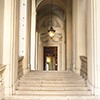This palace is an excellent example of a Baroque family residence. It has an imposing façade, whose portal is flanked by two columns supporting the balcony. The portal itself is topped off by the Altieri coat of arms – six stars. Its construction started in 1650 for Cardinal Emilio Bonaventura Altieri. When in 1670, he became pope, taking on the name Clement X, works were intensified while their range was expanded. Today it does not overburden with its grandeur, mainly due to the foreshortened perspective from which it can be admired. Its greatness is however, properly represented on old drawings.
This palace is an excellent example of a Baroque family residence. It has an imposing façade, whose portal is flanked by two columns supporting the balcony. The portal itself is topped off by the Altieri coat of arms – six stars. Its construction started in 1650 for Cardinal Emilio Bonaventura Altieri. When in 1670, he became pope, taking on the name Clement X, works were intensified while their range was expanded. Today it does not overburden with its grandeur, mainly due to the foreshortened perspective from which it can be admired. Its greatness is however, properly represented on old drawings.






















